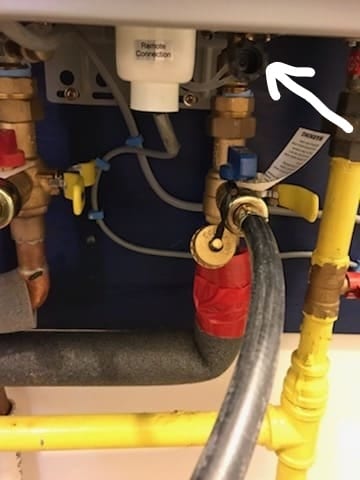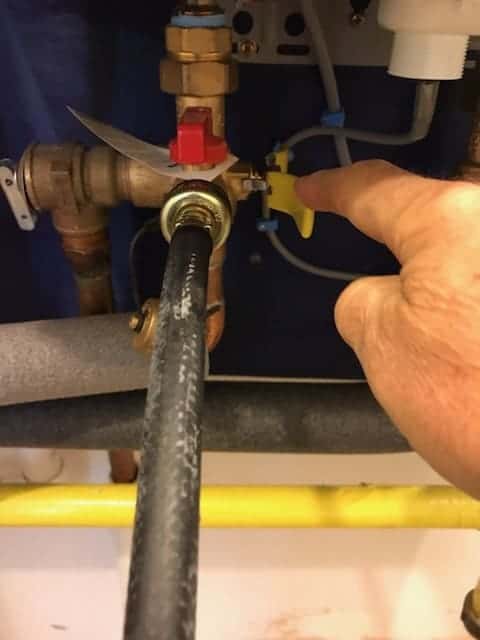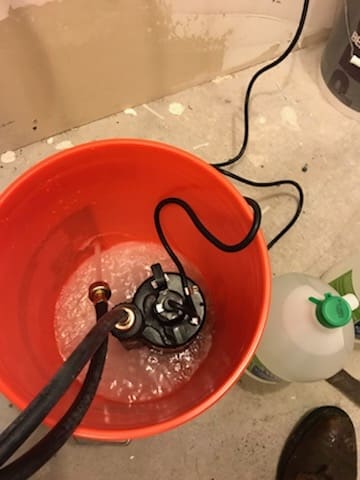I have a natural gas high-efficiency tankless water heater and found that it should be flushed once a year. I waited 2 1/2 years to do mine the first time, and there was a large amount of nasty stuff in the bucket at the end. I am sure the flushing increased the efficiency.
How to clean a tankless water heater with a vinegar flush.
The tools required are
- a clean 5-gallon bucket
- small submersible pump
- (2) washing machine connection hoses
- Pliers to remove the screen
- 3 gallons of vinegar
- paper towels to clean up any spilled water
The process will take between 2-4 hours, and you will be without hot water during the flushing. The longer you leave the vinegar moving through the water heater, the more mineral buildup will be removed.
Consult the water heaters owners manual before you start any flushing operation
Step 1 Prep the area
Remove and clean the area where the water heater is located. You will want some room to work in. Turning off the electricity by unplugging the unit from the outlet, and turn off the gas supply to the unit.

Step 2 Prep the unit
Close the isolation valves to each side of the unit and hook the hoses up to the hose bibs. They are screwed on just like a garden hose. Have the ends of the hoses in the bucket to catch any water that will come out. Open the valves that the hoses are connected to. A small amount of water, just a few cups, should come out of the hoses. (if water comes out under pressure, the supply valve is not shut completely)
Remove the filter screen and clean it by running it under cold water.
Do not lose the little O ring on the filter screen if it has one.
Reinstall the filter screen. Do not overtighten the filter screen, or you will damage it.

Step 3 Start the flushing.
Dispose of any water in the bucket; attach the hose from the cold supply side of the water heater to the submersible pump and place it in the bucket. Pour the vinegar into the bucket and plug the pump into the electrical outlet to turn it on. The pump should start running, and vinegar should come out of the hot water hose side of the water heater returning into the bucket. Let the pump recirculate the vinegar for 2-4 hours.
While you are waiting, this would be the time to wipe down your water heater and clean out the spider webs from the utility room.

Step 4 Flushing finished.
Now that the pump has recirculated the vinegar for 2-4 hours unplug it and disconnect the hose from it to drain the vinegar out of the water heater. Dispose of the vinegar; it makes a good grass killer, so don’t dump it out on the lawn.
Step 5: Make the unit rerun.
With the hoses in the bucket, turn on the cold water supply valve slowly and to about 1/4 way, flushing the vinegar out of the water heater and the hoses. If you turn the water supply to fully open, you will take a bath and have a mess to clean up.
Turn the cold water off, remove the filter screen, and clean it under running water.
Turn the water supply on slowly again to about 1/4 way open.
Reinstall the filter screen.
With the water running out of the hoses, turn the valve off on both hoses to stop the flow of water and prevent air from getting into the water heater.
Turn the cold supply valve to fully open and the hot supply to the house to open fully.
Go to the kitchen sink and run the hot water side of the faucet to clear the line of any trapped air. 1 minute should be enough.
Step 6 Start making hot water again.
Turn the gas supply back on, plug the unit back into the outlet, and turn the power on.
The unit may go through a startup procedure before any hot water is produced. Consult the owner’s manual to confirm the startup procedure for your unit.
Now is the time to fill the bucket half full with water and run the sump pump to empty the bucket and flush any vinegar out of the pump.
Dry the bucket, pump,
Can flushing the water heater damage it
Vinegar is a mild acid that dissolves the mineral buildup on the inside of the heat exchanger. The vinegar will only dissolve the mineral buildup and not the metal. I have seen where the flushing made a unit leak after the flushing because the heat exchanger had a defect and was leaking before the mineral buildup sealed over the defect.
Is there another product other than vinegar I can use to flush the water heater with
How much does the flush kit cost, and where can I get one
The flush kits, bucket, pump, and hoses run around a couple of hundred dollars online. There is a link on my resource page to view the price.
How often should the filter screen be cleaned?
Cleaning of the filter screen during the yearly flush should be enough unless:
- Your water system has sand in it, some wells will pump sand into the system, and you will see the sand in the bottom of the toilet tank if you have one of these wells.
- Work has been done to the supply side of your systems, like a water main repair or changing a pump or water meter. When these repairs are made, it is likely that air is introduced into the system, and when the air travels through the pipes, it will loosen and stir up any sand or sediment in the pipes, and then this sediment will travel into the screen.
- Your water source is lake-fed and has organic material in it.
What is the procedure for cleaning the filter
The procedure is similar to the flushing
- turn off the gas and electric
- turn off the supply water and the discharge water
- remove and clean the screen
- reinstall the screen
- Uncap the hot water side of the hose bib, open the valve about 1/4, and open the cold water supply the same amount. This is purging the air out of the water heater. Turn off the hot water hose valve and turn on the house’s cold and hot supply.
- Run the kitchen sink hot water to ensure no air in the water heater and line.
- Turn the gas and electricity back on.
I hope this article has helped you
Gary 2/9/2019, 1/31/2021, 4/6/2022 1,1,2023

